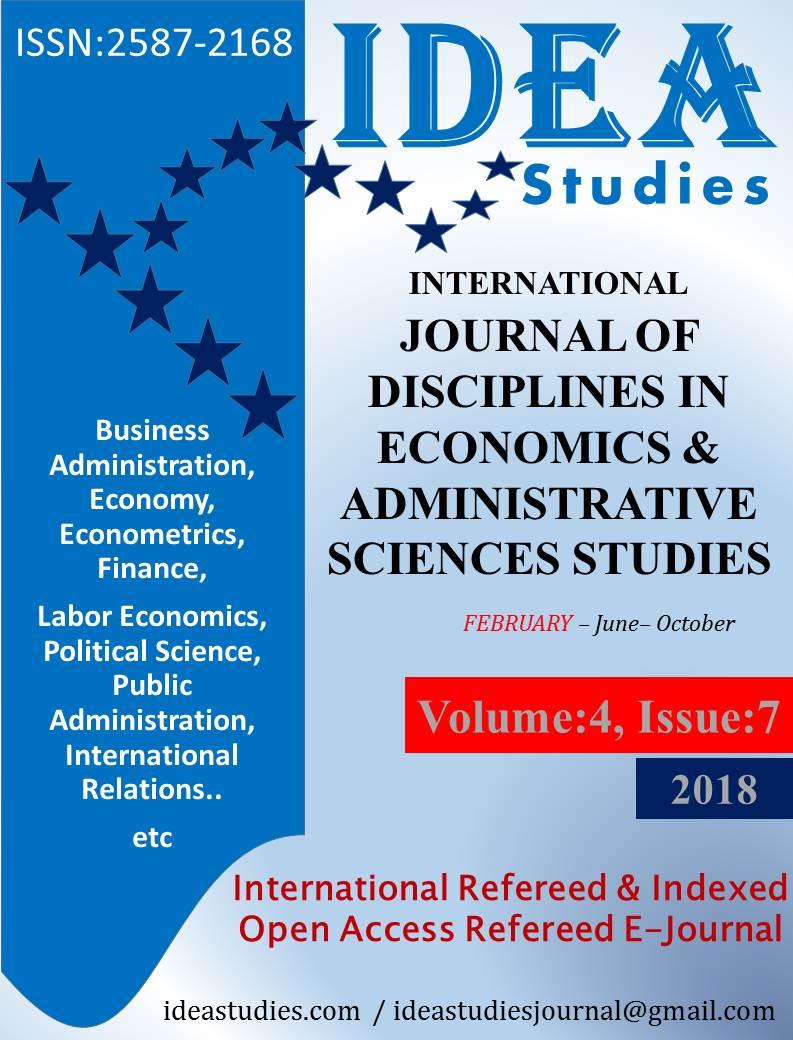Author :
Abstract
Gelişmişlik göstergesi olarak ifade edilen değişkenler açısından ülkelerin mevcut durumu analiz edildiğinde bazı göstergeler açısından iyi performansa sahip ülkelerin farklı göstergeler açısından düşük performans sergilediğini görmek mümkündür. Bu nedenle birden fazla kriterin aynı anda değerlendirmeye tabi tutulması daha faydalı ve kullanışlı sonuçlar verecektir. Bu çalışma ile OECD üye ülkelerinin temel sağlık göstergeleri, yaşam memnuniyeti, sağlık ve sosyal alanda sahip oldukları istihdam düzeyi gibi gelişmişlik ölçütü sayılabilecek kriterler açısından bir değerlendirme yaparak sıralanması amaçlanmıştır. Ülkelerin sıralaması gri ilişkisel analiz yöntemiyle gerçekleştirilmiştir. Bu kapsamda doğumdan beklenen yaşam süresi, toplam sağlık ve sosyal istihdam, algılanan sağlık durumu, yaşamdan memnuniyet düzeyi, anne ölüm hızı, bebek ölüm hızı ve kaybedilen potansiyel yaşam yılları değişken olarak analize dâhil edilmiştir. Değerlendirilen göstergeler açısından en iyi durumda olan ülkeler Norveç, İsviçre ve İsveç gibi Kuzey Avrupa ülkeleri olurken; Macaristan, Türkiye ve Meksika son sıralarda yer almıştır.
Keywords
Abstract
When the current situation of countries is analyzed in terms of variables expressed as development indicator, it is possible that some countries with good performance in terms of some indicators can show low performance in terms of different indicators. Therefore, assessment more than one criterion at the same time will give more helpful and useful results. This study aims to rank the OECD member countries in terms of criteria that can be regarded as development criteria, such as basic health indicators, life satisfaction, health and social status. The ranking of the countries was carried out by the grey relational analysis method. In this context, life expectancy at birth, total health and social employment, perceived health status, level of life satisfaction, maternal mortality rate, infant mortality rate and potential years of life lost are included in the analysis. Countries that are in the best position in terms of assessed indicators are Northern European countries such as Norway, Switzerland and Sweden; Hungary, Turkey and Mexico took place at the end.
Keywords
- Alptekin, N. & Yeşilaydın, G. (2015). “OECD Ülkelerinin Sağlık Göstergelerine Göre Bulanık
- Alptekin, N. & Yeşilaydın, G. (2015). “OECD Ülkelerinin Sağlık Göstergelerine Göre Bulanık Kümeleme Analizi İle Sınıflandırılması”, 7(4): 137-155.
- Avendano, M. (2012). “Correlation or causation? Income Inequality and İnfant Mortality İn FixedEffects Models ın the Period 1960-2008 in 34 OECD Countries”. Social Science & Medicine, 75:754-7760.
- Boz, C. & Önder, E. (2017). “OECD Ülkelerinin Sağlık Sistemi Performanslarının Değerlendirilmesi”, 6(11): 24-61.
- Daştan, İ. & Çetinkaya, V. (2015). “OECD Ülkeleri ve Türkiye’nin Sağlık Sistemleri, Sağlık Harcamaları ve Sağlık Göstergeleri Karşılaştırması”, Sosyal Güvenlik Dergisi, 5(1):104-134.
- Decancq, K. (2017). “Measuring Multidimensional Inequality in the OECD Member Countries with a Distribution-Sensitive Better Life Index”, Soc Indic Res, 131:1057-1086.
- Gaygısız, E. (2010). “Economıc and Cultural Correlates of Subjective Well-Being in CountriesUsing Data From the Organisation for Economic Co-Operation and Development (OECD)”, Psychological Reports, 106(3): 949-963.
- Heden, D. (2015). “Is İncome Inequality an Important Health Status Determinant ın the OECD ?,Lund University School of Economics and Management, Department of Economics: Master Essay.Julong, D. (1988). “Introduction to Grey System Theory”, The Journal of Grey System Theory, 1:1- 24.
- Kim, J.I. (2014). “Association Between Social Factors of Health Ageing and Longevity: Determinants of the Longevity İndex (LI) in OECD Countries”, Ageing Int, 39:97-105.
- Kõrreveski, K. (2011). “Measuring Well Being and Quality of Life Using OECD Indicators”, Quarterly Bulletin of Statistics Estonia, 11(4): 38-44.
- Kuo, Y.; Yang, T. & Huang, G.W. (2008). “The Use of Grey Relational Analysis in SolvingMultiple Attribute Decision-Making Problems”, Computers & Industrial Engineering, 55:80-93.
- Liu, S. & Forrest, J. (2007). “The Current Developing Status on Grey System Theory”, The Journal of Grey System, 2:111-123.
- Liu, S.; Tao, L. Xie, N. & Yang, Y. (2016). “On The New Model System and Framework of Grey System Theory”, The Journal of Grey System, 28(1):1-15.
- Pocas, A. & Soukiazis, E. (2010). “Health Status Determinants in the OECD Countries. A PanelData Approach With Endogenous Regressors”, 50th Congress of the European Regional ScienceAssociation: "Sustainable Regional Growth and Development in the Creative Knowledge Economy", 19-23 August 2010, Jönköping, Sweden.
- Safaei, J. (2015). “Distributional Orientation and Health Outcomes in OECD Countries”, International Journal of Health Services, 45(4): 601-621.
- Sağlık Araştırmaları Genel Müdürlüğü (2017). Sağlık İstatistikleri Yıllığı 2016, https://dosyasb.saglik.gov.tr/Eklenti/13183,sy2016turkcepdf.pdf?0, Erişim:[29.01.2018].
- Sayılı, U.; Sayman, Ö. A. Vehid, S. Köksal, S. S. & Erginöz, Ö. (2017). “ Türkiye ve OECDÜlkelerinin Sağlık Göstergeleri ve Sağlık Harcamalarının Karşılaştırılması”, Online Türk Sağlık Bilimleri Dergisi, 2(3): 1-12.
- Sonğur, C. (2016). Sağlık Göstergelerine Göre Ekonomik Kalkınma ve İşbirliği Örgütü Ülkelerinin Kümeleme Analizi, Sosyal Güvenlik Dergisi, 6(1): 197-224.
- Wang, S.; Ma, Q. & Guan, Z. (2007). “Measuring Hospital Efficiency in China Using GreyRelational Analysis and Data Envelopment Analysis”, IEEE International Conference on Grey Systems and Intelligent Services, Nanjing, China.
- Wu, J.H. & Chen, C.B. (2000). “An Alternative Form for Grey Relational Grade Analysis”. J. Chin. Inst. Ind. Eng. 17(2):147-156.
- Zeng, G.; Jiang, R. Huang, G. Xu, M. & Li, J. (2007). “Optimization of Wastewater TreatmentAlternative Selection by Hierarchy Grey Relational Analysis”, Journal of Environmental Management, 82: 250-259.





